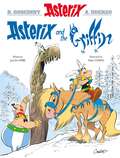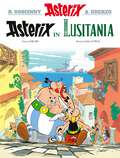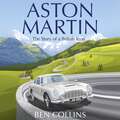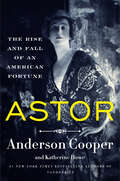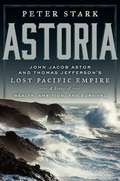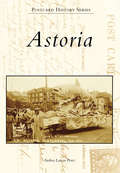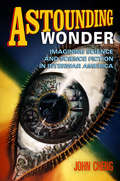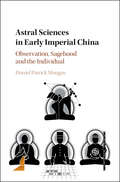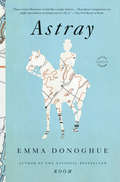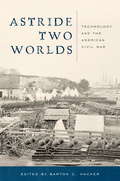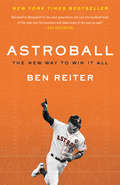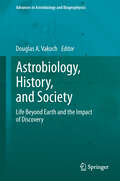- Table View
- List View
Astell: Political Writings
by Patricia Springborg Mary AstellThe writings of the High Church Tory pamphleteer Mary Astell (1666-1731) are a remarkable contribution to the constitutional debates that ushered in the modern democratic state. An interlocutor with Swift and Defoe, Astell was perhaps the first systematic critic of Locke's writings. Astell's political pamphlets Reflections upon Marriage, A Fair Way with the Dissenters, and An Impartial Enquiry into the Origins of Rebellion have never been reprinted in their entirety. This new edition makes accessible the major works of an important political theorist.
Asterix and the Griffin: Album 39 (Asterix #39)
by Jean-Yves FerriBe the first to read the next action-packed adventure from the indomitable Gauls by pre-ordering now!Follow Asterix and Obelix as they set out on their 39th adventure on a long journey in search of a strange and terrifying creature. Half-eagle, half-lion, and idolised and feared by ancient peoples, this creature is the griffin.How will Asterix, Obelix, Dogamatix, along with the Druid Getafix, get drawn into the epic, perilous quest to find this fantastical animal? Find out in the next instalment of this multi-million bestselling series.
Asterix in Lusitania: Asterix 41
by FabcaroOn 23rd October MMXXV there will be a new album of adventures for the most famous of Gauls: Asterix in Lusitania! One beautiful spring morning, a stranger appears in the Gaulish village. He's from Lusitania, the sun-drenched land to the west of Hispania which is also under the Roman Empire's thumb. This former slave, who first featured in The Mansions of the Gods, has come to ask our indomitable Gauls for help because he knows about the Magic Potion and its powerful effects. And so begins another adventure for Asterix and Obelix!
Asteroids
by Curtis PeeblesAsteroids suggest images of a catastrophic impact with Earth, triggering infernos, tidal waves, famine, and death -- but these scenarios have obscured the larger story of how asteroids have been discovered and studied. During the past two centuries, the quest for knowledge about asteroids has involved eminent scientists and amateur astronomers, patient research and sudden intuition, advanced technology and the simplest of telescopes, newspaper headlines and Cold War secrets. Today, researchers have named and identified the mineral composition of these objects. They range in size from 33 feet to 580 miles wide and most are found in a belt between the orbits of Mars and Jupiter.Covering all aspects of asteroid investigation, Curtis Peebles shows how ideas about the orbiting boulders have evolved. He describes how such phenomena as the Moon's craters and dinosaur extinction were gradually, and by some scientists grudgingly, accepted as the results of asteroid impacts. He tells how a band of icy asteroids rimming the solar system, first proposed as a theory in the 1940s, was ignored for more than forty years until renewed interest and technological breakthroughs confirmed the existence of the Kuiper Belt. Peebles also chronicles the discovery of Shoemaker-Levy 9, a comet with twenty-two nuclei that crashed into Jupiter in 1994, releasing many times the energy of the world's nuclear arsenal.Showing how asteroid research is increasingly collaborative, the book provides insights into the evolution of scientific ideas and the ebb and flow of scientific debate.
Aston Martin
by Richard LoveysAston Martin is a chronological account of the company's foundation in 1913 through to the cenetenary celebrations -covering the the owners, financiers, and those that ran the company -and most importantly the cars. Richard Loveys details the extensive competition history including their finest win at the 1959 Le Mans 24 hour race and includes details on Aston Martin's most famous drivers. Loveys also looks at Aston Martins in popular culture, most famously driven by James Bond and the use of these cars in 007 films.Finally, Loveys looks at the culture of the Aston Martin with the Aston Martin Owners Club which actively runs events and encourages people to use their cars on the road or to race them and the Aston Martin Heritage Trust, which holds the official archive for the company, has an excellent museum and encourages people to learn about the marque.
Aston Martin: Made in Britain
by Ben CollinsFrom bestselling author, racer and stunt driver Ben Collins - the man who was The Stig - comes a story of spies, speed and hard-driving genius: a driver's love letter to one of the world's best-loved machines.Aston Martin's first, wickedly fast models were forged at a time when Ferrari's premises at Maranello was nothing but a ploughed field. This book celebrates a century of innovators who kept the fire burning brightly for over a century, from the visionary pioneers Martin and Bamford to modern-day design guru Adrian Newey; from a glamorous web of pre- and post-war spies and racing drivers, to David Brown and the achingly beautiful DB models beloved of Bonds past and present.Ben Collins explores the car with the double-o prefix from a unique perspective behind the wheel, carving through country lanes in his father's V8 Vantage, driving Aston Martins in four James Bond movies and competing against them in the legendary Le Mans 24-hour race.Ultimately, this is a very British success story: of a triumph of engineering that has burned brightly from the Roaring 20s to the 2020s, and an iconic car that never says die.(P)2020 Quercus Editions Limited
Aston Martin: Made in Britain (Planet Omar Ser.)
by Ben Collins'This pacy history of a legendary brand is a love letter to an era of gears and gasoline now accelerating towards its twilight' - Financial Times'[Told] with a genuine affection ... a glorious tale of British seat-of-the-pants invention' - Mail on Sunday---------From bestselling author, racer and stunt driver Ben Collins - the man who was The Stig - comes a story of spies, speed and hard-driving genius: a driver's love letter to one of the world's best-loved machines.Aston Martin's first, wickedly fast models were forged at a time when Ferrari's premises at Maranello was nothing but a ploughed field. This book celebrates a century of innovators who kept the fire burning brightly for over a century, from the visionary pioneers Martin and Bamford to modern-day design guru Adrian Newey; from a glamorous web of pre- and post-war spies and racing drivers, to David Brown and the achingly beautiful DB models beloved of Bonds past and present.Ben Collins explores the car with the double-o prefix from a unique perspective behind the wheel, carving through country lanes in his father's V8 Vantage, driving Aston Martins in four James Bond movies and competing against them in the legendary Le Mans 24-hour race.Ultimately, this is a very British success story: of a triumph of engineering that has burned brightly from the Roaring 20s to the 2020s, and an iconic car that never says die.
Astor Place Vintage: A Novel
by Stephanie LehmannWhen a New York City vintage clothing shop owner’s recent purchases contain a hidden journal from 1907, her entire life will be turned upside down in this “insightful, charming, and wholly entertaining novel” (Khaled Hosseini, author of The Kite Runner).Amanda Rosenbloom, proprietor of Astor Place Vintage, thinks she’son just another call to appraise and possibly purchase clothing from a wealthy, elderly woman. But after discovering a journal sewn into a fur muff, Amanda gets much more than she anticipated. The pages of the journal reveal the life of Olive Westcott, a young woman who had moved to Manhattan in 1907. Olive was set on pursuing a career as a department store buyer in an era when Victorian ideas, limiting a woman’s sphere to marriage and motherhood, were only beginning to give way to modern ways of thinking. As Amanda reads the journal, her life begins to unravel until she can no longer ignore this voice from the past. Despite being separated by one hundred years, Amanda finds she’s connected to Olive in ways neither could ever have imagined.
Astor: The Rise and Fall of an American Fortune
by Anderson Cooper Katherine HoweA NPR Best Book of the YearThe number one New York Times bestselling authors of Vanderbilt return with another riveting history of a legendary American family, the Astors, and how they built and lavished their fortune.The story of the Astors is a quintessentially American story—of ambition, invention, destruction, and reinvention.From 1783, when German immigrant John Jacob Astor first arrived in the United States, until 2009, when Brooke Astor’s son, Anthony Marshall, was convicted of defrauding his elderly mother, the Astor name occupied a unique place in American society.The family fortune, first made by a beaver trapping business that grew into an empire, was then amplified by holdings in Manhattan real estate. Over the ensuing generations, Astors ruled Gilded Age New York society and inserted themselves into political and cultural life, but also suffered the most famous loss on the Titanic, one of many shocking and unexpected twists in the family’s story.In this unconventional, page-turning historical biography, featuring black-and-white and color photographs, #1 New York Times bestselling authors Anderson Cooper and Katherine Howe chronicle the lives of the Astors and explore what the Astor name has come to mean in America—offering a window onto the making of America itself.
Astoria
by Peter StarkIn 1810, John Jacob Astor sent out two advance parties to settle the wild, unclaimed western coast of North America. More than half of his men died violent deaths. The others survived starvation, madness, and greed to shape the destiny of a continent.At a time when the edge of American settlement barely reached beyond the Appalachian Mountains, two visionaries, President Thomas Jefferson and millionaire John Jacob Astor, foresaw that one day the Pacific would dominate world trade as much as the Atlantic did in their day. Just two years after the Lewis and Clark expedition concluded in 1806, Jefferson and Astor turned their sights westward once again. Thus began one of history's dramatic but largely forgotten turning points in the conquest of the North American continent.Astoria is the harrowing tale of the quest to settle a Jamestown-like colony on the Pacific coast. Astor set out to establish a global trade network based at the mouth of the Columbia River in what is now Oregon, while Jefferson envisioned a separate democracy on the western coast that would spread eastward to meet the young United States.Astor backed this ambitious enterprise with the vast for-tune he'd made in the fur trade and in New York real estate since arriving in the United States as a near-penniless immigrant soon after the Revolutionary War. He dispatched two groups of men west: one by sea around the southern tip of South America and one by land over the Rockies. The Overland Party, led by the gentlemanly American businessman Wilson Price Hunt, combined French-Canadian voyageurs, Scottish fur traders, American woodsmen, and an extraordinary Native American woman with two toddlers. The Seagoing Party, sailing aboard the ship Tonquin, likewise was a volatile microcosm of contemporary North America. Under the bitter eye of Captain Jonathan Thorn, a young U.S. naval hero whose unyielding, belligerent nature was better suited to battle than to negotiating cultural differences, the Tonquin made tumultuous progress toward its violent end.Unfolding from 1810 to 1813, Astoria is a tale of high adventure and incredible hardship, drawing extensively on firsthand accounts of those who made the journey. Though the colony itself would be short-lived, its founders opened provincial American eyes to the remarkable potential of the western coast, discovered the route that became the Oregon Trail, and permanently altered the nation's landscape and global standing.
Astoria (Postcard History)
by Andrea Larson PerezFortunate to be located in the northwest corner of Oregon, where the mighty Columbia River flows to the Pacific Ocean, Astoria has always inspired residents and visitors. The town's spectacular natural beauty and accessible everyday life invites documentation. Those lucky enough to experience Astoria sense they are witnessing something special. More than a century ago, it was a place of big fish, big trees, big dreams, and big personalities. Luckily, many professional photographers and everyday shutterbugs made it their business to capture life on the Lower Columbia from the earliest days of photography. Today, there are fewer giant Chinooks and the remaining old growth is protected, but the town, dreams, personalities, and photographs remain.
Astounding Wonder
by John ChengWhen physicist Robert Goddard, whose career was inspired by H. G. Wells's War of the Worlds, published "A Method of Reaching Extreme Altitudes," the response was electric. Newspaper headlines across the country announced, "Modern Jules Verne Invents Rocket to Reach Moon," while people from around the world, including two World War I pilots, volunteered as pioneers in space exploration. Though premature (Goddard's rocket, alas, was only imagined), the episode demonstrated not only science's general popularity but also its intersection with interwar popular and commercial culture. In that intersection, the stories that inspired Goddard and others became a recognizable genre: science fiction. Astounding Wonder explores science fiction's emergence in the era's "pulps," colorful magazines that shouted from the newsstands, attracting an extraordinarily loyal and active audience.Pulps invited readers not only to read science fiction but also to participate in it, joining writers and editors in celebrating a collective wonder for and investment in the potential of science. But in conjuring fantastic machines, travel across time and space, unexplored worlds, and alien foes, science fiction offered more than rousing adventure and romance. It also assuaged contemporary concerns about nation, gender, race, authority, ability, and progress--about the place of ordinary individuals within modern science and society--in the process freeing readers to debate scientific theories and implications separate from such concerns.Readers similarly sought to establish their worth and place outside the pulps. Organizing clubs and conventions and producing their own magazines, some expanded science fiction's community and created a fan subculture separate from the professional pulp industry. Others formed societies to launch and experiment with rockets. From debating relativity and the use of slang in the future to printing purple fanzines and calculating the speed of spaceships, fans' enthusiastic industry revealed the tensions between popular science and modern science. Even as it inspired readers' imagination and activities, science fiction's participatory ethos sparked debates about amateurs and professionals that divided the worlds of science fiction in the 1930s and after.
Astraea - Yates: The Imperial Theme In The Sixteenth Century (Peregrine Bks.)
by Frances A. YatesThis is Volume V of selected works of Frances A. Yates. Astraea looks at the Imperial theme in the sixteenth century and includes Charles V and the idea of Empire to the Tudor Imperial Reform and the French Monarchy.
Astral Projection: A Record Of Out-of-body Experiences
by Oliver FoxAstral Projection, first published in 1962 (based on papers prepared in the 1930s), is a classic account of one man's own documented experiences with 'astral projection,' or as he prefers, 'out-of-body' experiences. The book also serves as a 'how-to' guide, describing two techniques for initiating an out-of-body experience: dream awakening and the pineal doorway. Clearly written with a refreshing charm and sincerity, Astral Projection remains a useful guide to those exploring this realm of psychic experience. Oliver Fox was a pseudonym for Hugh George Callaway (1885-1949), an English short story writer, poet and occultist.
Astral Projection: A Record of Out-of-the-Body Experiences
by H. G. Colloway"Astral Projection: A Record of Out-of-the-Body Experiences" by H. G. Colloway is an enthralling and enlightening exploration of the fascinating phenomenon of astral projection. Colloway, a pioneering researcher in the field of metaphysics, presents a compelling account of his own out-of-body experiences, offering readers a unique and detailed perspective on this mysterious and often misunderstood practice.In this captivating work, Colloway shares his personal journey into the realm of astral projection, recounting his vivid and transformative experiences beyond the physical body. He provides an in-depth look at the techniques he employed, the challenges he faced, and the profound insights he gained during his excursions into the astral plane.Colloway's narrative is both accessible and profound, making complex concepts understandable for readers of all backgrounds. He delves into the historical and cultural contexts of astral projection, drawing connections between ancient practices and modern-day explorations. By blending personal anecdotes with scholarly research, Colloway offers a comprehensive guide to understanding and experiencing astral projection."Astral Projection: A Record of Out-of-the-Body Experiences" covers a wide range of topics, including methods for inducing astral travel, navigating the astral plane, and the potential benefits and risks associated with out-of-body experiences. Colloway also addresses common misconceptions and provides practical advice for those interested in exploring this intriguing phenomenon for themselves.This book is an invaluable resource for anyone curious about the nature of consciousness and the possibilities of human potential. Whether you are a seasoned practitioner or a novice eager to learn more, Colloway's insights and experiences offer a thought-provoking and inspiring journey into the world of astral projection.H. G. Colloway's "Astral Projection" is a must-read for metaphysical enthusiasts, spiritual seekers, and anyone interested in the extraordinary capacities of the human mind. It stands as a testament to the enduring mystery and wonder of out-of-body experiences, inviting readers to expand their horizons and explore the limitless potential of the astral realm.
Astral Sciences in Early Imperial China: Observation, Sagehood and the Individual
by Morgan Daniel PatrickChallenging monolithic modern narratives about 'Chinese science', Daniel Patrick Morgan examines the astral sciences in China c. 221 BCE-750 CE as a study in the disunities of scientific cultures and the narratives by which ancients and moderns alike have fought to instil them with a sense of unity. The book focuses on four unifying 'legends' recounted by contemporary subjects: the first two, redolent of antiquity, are the 'observing of signs' and 'granting of seasons' by ancient sage kings; and the other two, redolent of modernity, involve the pursuit of 'accuracy' and historical 'accumulation' to this end. Juxtaposing legend with the messy realities of practice, Morgan reveals how such narratives were told, imagined, and re-imagined in response to evolving tensions. He argues that, whether or not 'empiricism' and 'progress' are real, we must consider the real effects of such narratives as believed in and acted upon in the history of astronomy in China.
Astral Weeks: A Secret History of 1968
by Ryan H. WalshA mind-expanding dive into a lost chapter of 1968, featuring the famous and forgotten: Van Morrison, folkie-turned-cult-leader Mel Lyman, Timothy Leary, James Brown, and many more Van Morrison's Astral Weeks is an iconic rock album shrouded in legend, a masterpiece that has touched generations of listeners and influenced everyone from Bruce Springsteen to Martin Scorsese. In his first book, acclaimed musician and journalist Ryan H. Walsh unearths the album's fascinating backstory--along with the untold secrets of the time and place that birthed it: Boston 1968.On the 50th anniversary of that tumultuous year, Walsh's book follows a criss-crossing cast of musicians and visionaries, artists and hippie entrepreneurs, from a young Tufts English professor who walks into a job as a host for TV's wildest show (one episode required two sets, each tuned to a different channel) to the mystically inclined owner of radio station WBCN, who believed he was the reincarnation of a scientist from Atlantis. Most penetratingly powerful of all is Mel Lyman, the folk-music star who decided he was God, then controlled the lives of his many followers via acid, astrology, and an underground newspaper called Avatar.A mesmerizing group of boldface names pops to life in Astral Weeks: James Brown quells tensions the night after Martin Luther King, Jr. is assassinated; the real-life crimes of the Boston Strangler come to the movie screen via Tony Curtis; Howard Zinn testifies for Avatar in the courtroom. From life-changing concerts and chilling crimes, to acid experiments and film shoots, Astral Weeks is the secret, wild history of a unique time and place.One of LitHub's 15 Books You Should Read This March
Astralabe: The Life and Times of the Son of Heloise and Abelard (The New Middle Ages)
by Brenda M. CookTwo of the most notable figures from the Middle Ages–the volatile, brilliant Abelard and the equally brilliant Heloise–became the parents of their son Astralabe before Abelard’s infamous, brutal castration. The couple spent the rest of their lives as monastics, in each other’s orbits if not in shared presence, as they became movers in the glittering monastic world of the early twelfth-century France. What happened to their strangely named Astralabe? Astralabe: The Life and Times of the Son of Heloise and Abelard rescues the “lost son” from footnotes and fiction and attempts to tell instead the story of a real man living in Europe in the twelfth century. This book assembles the references to Astralabe, provides background in the history of France and Switzerland, uncovers Abelard’s relationships with his family, with the ruling house of Brittany and more, and most importantly draws together all that is known of Astralabe.
Astray
by Emma DonoghueThe fascinating characters that roam across the pages of Emma Donoghue's stories have all gone astray: they are emigrants, runaways, drifters, lovers old and new. They are gold miners and counterfeiters, attorneys and slaves. They cross other borders too: those of race, law, sex, and sanity. They travel for love or money, incognito or under duress. With rich historical detail, the celebrated author of Room takes us from puritan Massachusetts to revolutionary New Jersey, antebellum Louisiana to the Toronto highway, lighting up four centuries of wanderings that have profound echoes in the present. Astray offers us a surprising and moving history for restless times.
Astrid Lindgren: The Woman Behind Pippi Longstocking
by Jens Andersen Caroline WaightThe first English‑language biography of Astrid Lindgren provides a moving and revealing portrait of the beloved Scandinavian literary icon whose adventures of Pippi Longstocking have influenced generations of young readers all over the world. Lindgren’s sometimes turbulent life as an unwed teenage mother, outspoken advocate for the rights of women and children, and celebrated editor and author is chronicled in fascinating detail by Jens Andersen, one of Denmark’s most popular biographers. Based on extensive research and access to primary sources and letters, this highly readable account describes Lindgren’s battles with depression and her personal struggles through war, poverty, motherhood, and fame. Andersen examines the writer’s oeuvre as well to uncover the secrets to the books’ universal appeal and why they have resonated so strongly with young readers for more than seventy years.
Astrid Taim's Almaguin Chronicles 2-Book Bundle: Almaguin / Almaguin Chronicles
by Astrid TaimThe Almaguin Highlands, an extensive territory covering a 90 kilometre corridor from Huntsville, north to Callander, west to Dunchurch, and east to the Algonquin Park border, is a land rich with lakes, rivers, and a lively history. Once considered as a site for a First Nations Reserve in the early 1800s, Almaguin became a centre for lumbering and ultimately a year-round mecca for outdoor enthusiasts. This 2-book bundle is Astrid Taim's definitive guide to the region and its heritage. Almaguin: A Highland History offers a wide range of stories from the opening of the area by colonization roads to the first vessels on the Magnetawan River and the courage of the early pioneers. Included are community histories of the many towns, villages, and ghost towns of today; profiles of colourful personalities; as well as interesting and amusing tales of these rugged early times. Almaguin Chronicles explores the relationship between lumbering and settlement throughout the Parry Sound District — the last frontier of this part of Ontario. Throughout, rare archival photographs and excerpts from unpublished memoirs augment the text.
Astride Two Worlds
by Barton C. HackerBy the middle of the nineteenth century, industrialization and military-technological innovation were beginning to alter drastically the character and conditions of warfare as it had been conducted for centuries. Occurring in the midst of these far-reaching changes, the American Civil War can justly be labeled both the last great preindustrial war and the first major war of the industrial age. Industrial capacity attained new levels of military significance as transportation improved, but in this, as in many other respects, the Civil War was distinctly transitional. Smoothbore artillery still dominated the battlefield, horse-drawn wagons and pack mules still carried the main logistic burden, seamstresses still outnumbered sewing-machine operators. Astride Two Worlds addresses the various causes and consequences of technological change for the course and outcome of the American Civil War.
Astroball: The New Way to Win It All
by Ben ReiterWhen Sports Illustrated declared on the cover of a June 2014 issue that the Houston Astros would win the World Series in 2017, people thought Ben Reiter, the article’s author, was crazy. <P><P>The Astros were the worst baseball team in half a century, but they were more than just bad. They were an embarrassment, a club that didn’t even appear to be trying to win. The cover story, combined with the specificity of Reiter’s claim, met instant and nearly universal derision. <P><P>But three years later, the critics were proved improbably, astonishingly wrong. How had Reiter predicted it so accurately? And, more important, how had the Astros pulled off the impossible? <P><P>Astroball is the inside story of how a gang of outsiders went beyond the stats to find a new way to win—and not just in baseball. When new Astros general manager Jeff Luhnow and his top analyst, the former rocket scientist Sig Mejdal, arrived in Houston in 2011, they had already spent more than half a decade trying to understand how human instinct and expertise could be blended with hard numbers such as on-base percentage and strikeout rate to guide their decision-making. <P><P>In Houston, they had free rein to remake the club. No longer would scouts, with all their subjective, hard-to-quantify opinions, be forced into opposition with the stats guys. Instead, Luhnow and Sig wanted to correct for the biases inherent in human observation, and then roll their scouts’ critical thoughts into their process. The numbers had value—but so did the gut. <P><P>The strategy paid off brilliantly, and surprisingly quickly. It pointed the Astros toward key draft picks like Carlos Correa and Alex Bregman; offered a path for developing George Springer, José Altuve, and Dallas Keuchel; and showed them how veterans like Carlos Beltrán and Justin Verlander represented the last piece in the puzzle of fielding a championship team. <P><P>Sitting at the nexus of sports, business, and innovation—and written with years of access to the team’s stars and executives—Astroball is the story of the next wave of thinking in baseball and beyond, at once a remarkable underdog story and a fascinating look at the cutting edge of evaluating and optimizing human potential.
Astrobiology, History, and Society: Life Beyond Earth and the Impact of Discovery (Advances in Astrobiology and Biogeophysics)
by Douglas A. VakochThis book addresses important current and historical topics in astrobiology and the search for life beyond Earth, including the search for extraterrestrial intelligence (SETI). The first section covers the plurality of worlds debate from antiquity through the nineteenth century, while section two covers the extraterrestrial life debate from the twentieth century to the present. The final section examines the societal impact of discovering life beyond Earth, including both cultural and religious dimensions. Throughout the book, authors draw links between their own chapters and those of other contributors, emphasizing the interconnections between the various strands of the history and societal impact of the search for extraterrestrial life. The chapters are all written by internationally recognized experts and are carefully edited by Douglas Vakoch, professor of clinical psychology at the California Institute of Integral Studies and Director of Interstellar Message Composition at the SETI Institute. This interdisciplinary book will benefit everybody trying to understand the meaning of astrobiology and SETI for our human society.

